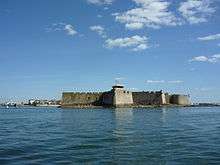Port-Louis, Morbihan
| Port-Louis Porzh-Loeiz | ||
|---|---|---|
|
Citadel of Port-Louis | ||
| ||
 Port-Louis | ||
|
Location within Brittany region  Port-Louis | ||
| Coordinates: 47°42′26″N 3°21′07″W / 47.7072°N 3.3519°WCoordinates: 47°42′26″N 3°21′07″W / 47.7072°N 3.3519°W | ||
| Country | France | |
| Region | Brittany | |
| Department | Morbihan | |
| Arrondissement | Lorient | |
| Canton | Port-Louis | |
| Intercommunality | Pays de Lorient | |
| Government | ||
| • Mayor (2008—2014) | Muriel Jourda | |
| Area1 | 1.07 km2 (0.41 sq mi) | |
| Population (1999)2 | 2,808 | |
| • Density | 2,600/km2 (6,800/sq mi) | |
| Time zone | CET (UTC+1) | |
| • Summer (DST) | CEST (UTC+2) | |
| INSEE/Postal code | 56181 / 56290 | |
| Elevation | 0–14 m (0–46 ft) | |
|
1 French Land Register data, which excludes lakes, ponds, glaciers > 1 km² (0.386 sq mi or 247 acres) and river estuaries. 2 Population without double counting: residents of multiple communes (e.g., students and military personnel) only counted once. | ||

Port-Louis (Breton: Porzh-Loeiz) is a commune in the Morbihan department of Brittany in north-western France. Inhabitants of Port-Louis are called in French Port-Louisiens.
History
At the beginning of the 17th century, merchants who were trading with India established warehouses in Port-Louis. They later built additional warehouses across the bay in 1628, at the location which became known as "L'Orient" (the Orient in French). In 1664, during the reign of King Louis XIV, the French East India Company was established at Port-Louis. The company established a shipyard at Lorient. The Company was not able to maintain itself financially, and it was abolished in 1769. In 1770, King Louis XVI issued an edict that required the Company to transfer to the state all its properties, in return for which the King agreed to pay all of the Company’s debts and obligations. The French government then took over the shipyards as a naval port and arsenal.
Citadel
The Spanish engineer Cristobal de Rojas built the Fuerte de Aguila in 1590 at what was then known as Port Plavet during the War of the Catholic League. At the time, the governor of Brittany, Philippe Emmanuel, Duke of Mercœur, a Catholic, was in revolt against King Henry IV, a Protestant, and the Spaniards came to provide support to their coreligionists. The King converted to Catholicism in 1593, and eventually defeated de Mercour in 1598, gaining control of the fort. The fort was extended in 1616-1636, during the reign of King Louis XIII. In 1836 Louis Napoleon, the future Emperor Napoleon III, was a prisoner in the citadel. Later prisoners included 1836, Communards and members of the French Resistance, among others.
Today, the citadel houses four museums:
- Museum of the French East India Company (Musée de la Compagnie des Indes)
- Museum of Naval Weapons (Musée des Armes Navales)
- Museum of Port-Louis and the CItadel (Musée de Port-Louis et de la Citadelle)
- Museum of the Arsenal (Musée de l'Arsenal)
_-_Entr%C3%A9e_2.jpg)
See also
References
External links
| Wikimedia Commons has media related to Port-Louis. |
- Official website (French)
- French Ministry of Culture list for Port-Louis (French)
- Map of Port-Louis on Michelin (English)

.svg.png)